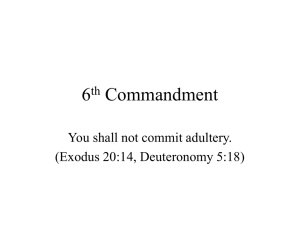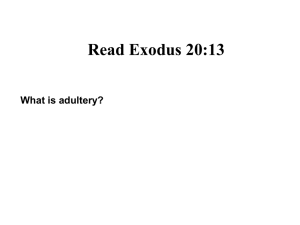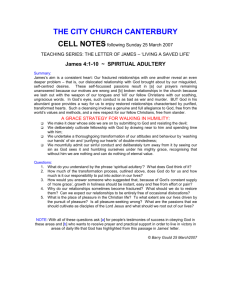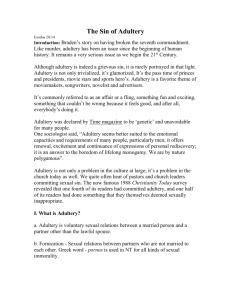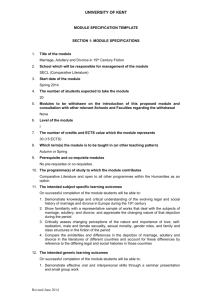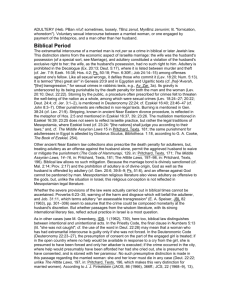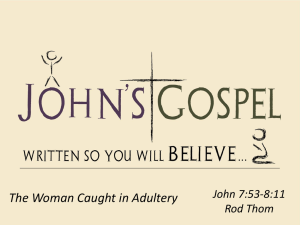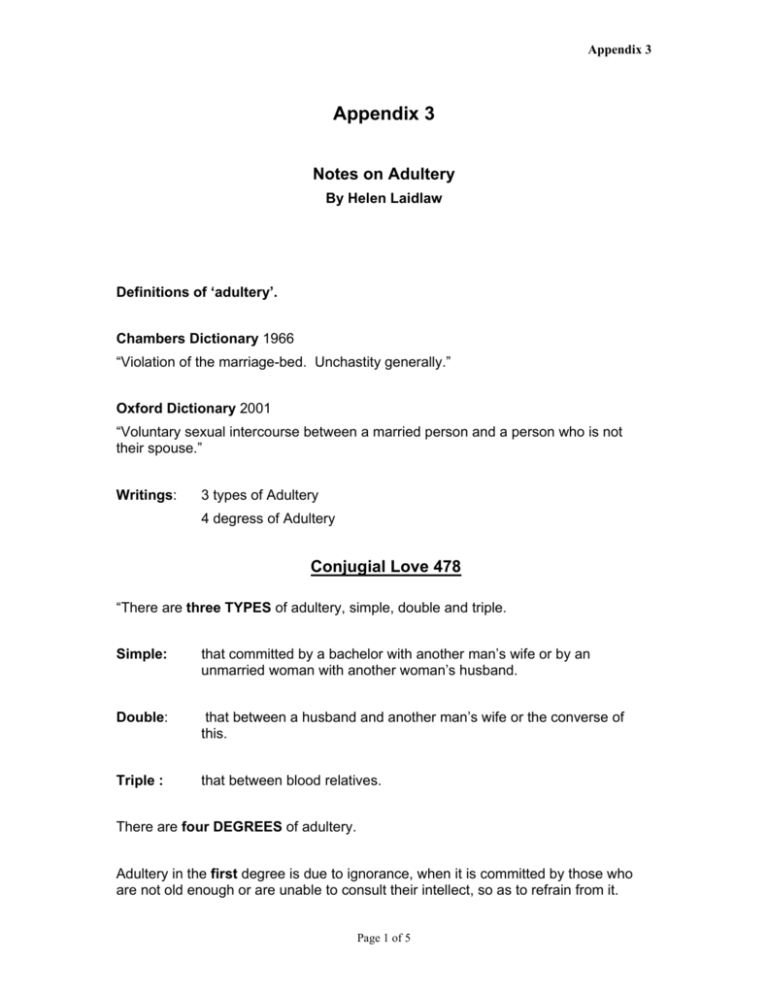
Appendix 3
Appendix 3
Notes on Adultery
By Helen Laidlaw
Definitions of ‘adultery’.
Chambers Dictionary 1966
“Violation of the marriage-bed. Unchastity generally.”
Oxford Dictionary 2001
“Voluntary sexual intercourse between a married person and a person who is not
their spouse.”
Writings:
3 types of Adultery
4 degress of Adultery
Conjugial Love 478
“There are three TYPES of adultery, simple, double and triple.
Simple:
that committed by a bachelor with another man’s wife or by an
unmarried woman with another woman’s husband.
Double:
that between a husband and another man’s wife or the converse of
this.
Triple :
that between blood relatives.
There are four DEGREES of adultery.
Adultery in the first degree is due to ignorance, when it is committed by those who
are not old enough or are unable to consult their intellect, so as to refrain from it.
Page 1 of 5
Appendix 3
Adultery committed by these people is a mild offence.
Adultery in the second degree is due to lust, when it is committed by those who can
certainly consult their intellect, but are unable to do so at the time for circumstantial
reasons.
Adultery by these persons is imputed, depending on whether their intellect afterwards
approves or disapproves.
Adultery in the third degree is adultery approved by reason, when committed by
those who convince themselves intellectually that it is not a sinful evil.
Adultery by these persons is a serious offence and it is imputed depending upon how
far they are convinced of this.
Adultery in the fourth degree is adultery approved by the will, when committed by
those who regard it as allowable and accepted, not deserving any consultation of the
intellect on the subject.
Adultery committed by these persons is an offence of the most serious kind, being
imputed to them as intentional evil, and weighing on them as guilt.”
Adultery is considered as different from fornication in that it supposes the marriage
of one or both of the people involved.
In some cultures, adultery is still rigorously condemned and punished. Just recently
there was an outcry about a woman being condemned to being ‘stoned’ because of
alleged adultery. But it seems as though the condemnation and punishment is
because the ‘adultery’ is considered a violation of the husband’s rights. In many
instances the ‘wife’ is considered the property of the husband and adultery is
identified as ‘theft’. In other words, the wife could be guilty of “adultery” but never the
husband.
Quote from paper on ethics/divorce on the net:
“In the Bible adultery is condemned in both the Old and New Testaments. The most
famous prohibition is the seventh commandment, ‘You shall not commit adultery’
(Exodus 20: 14) Adultery is usually understood as a violation of property rights. In
the Bible, women were treated very much as possessions and although they had
Page 2 of 5
Appendix 3
rights these were restricted. In terms of marriage a woman belonged to her husband
and it is against this background that issues of adultery are discussed. Although men
and women were equally capable of committing adultery it is only the women who
can commit adultery against her husband. This is because she is breaching his
property rights. A man had sole rights over his wife’s body and adultery was
punishable by death.”
In Greek/Roman times there were stringent laws against adultery but once again they
discriminated against the wife.
In 1857 the English Parliament passed a law by which a husband could obtain an
absolute divorce on account of simple adultery in his wife while the wife could only be
freed from her adulterous husband when his infidelity involved cruelty “as would have
entitled her to a divorce a mensa et toro.”
How prevalent is adultery?
A survey by the National Opinion Research Centre (University of Chicago) found
25% of men had been unfaithful and 17% of women. Whatever the figures it would
seem that adultery is much more common than we would like to admit. Has the fact
that adultery has become commonplace altered our perception of it?
Interestingly, a recent study has concluded that one fifth of 25-34 year olds have had
more than ten sexual partners but they believed in marital faithfulness - 78% of
this group believed that having an extramarital affair was wrong.
(This compared with 69% of 45-54 years olds).
According to another survey by Newsweek magazine this is not just a problem with
non-Christians and it quoted that as many as 30% of male Protestant ministers have
had sexual relationships with women other than their wives.
How much influence do films and T.V. programmes have on our attitude to adultery?
e.g. “The English Patient” received twelve Oscar nominations including best picture
of the year for its depiction of an adulterous relationship. “The Prince of Tides”
received seven Oscar nominations. “The Bridges of Madison County” relates the
story of a farmer’s wife who has a brief affair with a photographer.
Page 3 of 5
Appendix 3
The term ‘adultery’ is often softened to such terms as: fooling around, sleeping
around, flings, affairs and dalliances. Suggesting that adultery can be guilt free and
harms no one.
Adultery destroys marriages and families and often leads to divorce and public
sentiment against adultery is actually very strong. Yet although we consider adultery
to be wrong and know that it can be devastating many people still believe myths such
as:
“Adultery is about sex”
“Adultery is about character”
“Adultery is therapeutic”
“Adultery is harmless”
PAUL VICKERS
“Living with God”
Page 105
“The real destroyer of marriage is a love of adultery. This involves a disregard of the
trust and intimacy that has been shared in marriage in such a way that there is a
willingness to hurt the partner. Any real marriage has involved the opening of
thoughts to each other at the most intimate level. It has built a trust in the joy they
have in each other and what they feel together. The love of adultery wants to destroy
that trust and joy. It can exist without the act of adultery if depraved enjoyment and
behaviour satisfy its lusts, or if there is a deliberate wish to abandon the partner so
that no real trust or intimacy remains.
Such a destruction of a marriage destroys the basis of love from which the partner
has lived perhaps for many years. It breaks up the structure of desires and
consequent thoughts that has been the whole nature of that person. The trauma it
induces is very great indeed for it leaves almost a vacuum in the mind and life of the
sufferer. It is against these cases that the Gospel makes its strictures on adultery and
speaks of divorce. The incident of the woman taken in adultery in John’s Gospel
makes clear that it is not so much in the act of adultery that the Lord sees such a
complete destruction of marriage as in the love of adultery that destroy a trusting
partner.
What the Lord then says of divorce is really a statement of the condition the marriage
has been brought to. It is commonly used to discuss whether a man and a woman
Page 4 of 5
Appendix 3
may break a marriage in the external sense. Its real point is that the marriage has
ceased to exist in any inner sense. Obviously we cannot judge whether that is so in
any particular case. If one of the parties tells us it is so, then clearly counselling
should be attempted …… If one of the partners is in such a state as the love of
adultery, it is clear that he or she cannot form a true marriage. If later there is
repentance and the love of adultery is rejected by a life of service to God then
that person may again be able to enter into a true relation”. Again we cannot
judge.
A lack of spiritual commitment in marriage seems to go with an ‘easy’ attitude about
adultery.
Page 5 of 5

